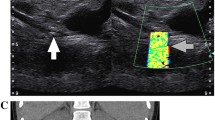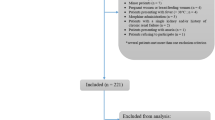Summary
Background
The aim of this article is to investigate the possible impact of timing of ultrasound (US) during the day or week on its diagnostic accuracy.
Methods
We analyzed the records of 500 patients who underwent an initial urinary US, followed by a noncontrast computed tomography (NCCT) for the assessment of urinary stone disease. The sensitivity, specificity, negative and positive predictive values, negative and positive likelihood ratio, and overall diagnostic accuracy rates of US and were analyzed at different times of the day or week.
Results
The specificity and diagnostic accuracy of urinary US showed a decline toward the middle of the week followed by a steady rise by the end of the week, higher sensitivity for urinary US was noticed around mid-week. On the other hand, when urinary US results are subgrouped according to the time of the day they are performed, the specificity remained generally stable but the sensitivity and diagnostic accuracy showed lowest levels between 11:00 a.m. and 02:00 p.m. and between 04:00 p.m. and 05:00 p.m. Although some observational differences between sensitivity, specificity, and diagnostic accuracy of urinary US performed at different times of the day or week are seen, these differences were not statistically significant.
Conclusions
Our study showed no significant influence of US timing on its diagnostic accuracy. A larger randomized prospective series is necessary to evaluate the impact of different factors on “precision” and “accuracy” in US reporting and, hence, the diagnostic accuracy of urinary US in identifying urinary stone disease.


Similar content being viewed by others
References
Ray AA, Ghiculete D, Pace KT, et al. Limitations to ultrasound in the detection and measurement of urinary tract calculi. Urology. 2010;76:295–300.
Romero V, Akpinar H, Assimos DG. Kidney stones: a global picture of prevalence, incidence, and associated risk factors. Rev Urol. 2010;12:86–96.
Teichman J. Clinical practice. Acute renal colic from ureteral calculus. N Engl J Med. 2004;350:684–93.
Tepeler A, Sancaktutar AA, Taskiran M, et al. Preoperative evaluation of pediatric kidney prior to percutaneous nephrolithotomy: is computed tomography really necessary? Urolithiasis. 2013;41:505–10.
Resorlu B, Kara C, Resorlu EB, et al. Effectiveness of ultrasonography in the postoperative follow-up of pediatric patients undergoing ureteroscopic stone manipulation. Pediatr Surg Int. 2011;27:1337–41.
Ulusan S, Koc Z, Tokmak N. Accuracy of sonography for detecting renal stone: comparison with CT. J Clin Ultrasound. 2007;35:256–61.
Passerotti C, Chow JS, Silva A, et al. Ultrasound versus computerized tomography for evaluating urolithiasis. J Urol. 2009;182:1829–34.
Bez Y, Emhan A, Ari M, et al. Monday anxiety in office workers. Düşünen Adam. J Psychiatry Neurol Sci. 2011;24:38–43.
Campolieti M, Hyatt DE. Further evidence on the ‘monday effect’ in workers’ compensation. Ind Labor Relat Rev. 2006;59:438–50.
Krauss T, Frauenfelder T, Strebel RT, et al. Unenhanced versus multiphase MDCT in patients with hematuria, flank pain, and a negative ultrasound. Eur J Radiol. 2012;81:417–22.
Resorlu M, Adam G, Uysal F, Ozdemir H. Re: imaging the urologic patient: the utility of intravenous pyelogram in the CT scan era. World J Urol. 2013. doi:10.1007/s00345-013-1156-6.
Yilmaz S, Sindel T, Arslan G, et al. Renal colic: comparison of spiral CT, US and IVU in the detection of ureteral calculi. Eur Urol. 1998;8:212–7.
Sheafor DH, Hertzberg BS, Freed KS, et al. Nonenhanced helical CT and US in the emergency evaluation of patients with renal colic: prospective comparison. Radiology. 2000;217:792–7.
King W, Kimme-Smith C, Winter J. Renal stone shadowing: an investigation of contributing factors. Radiology. 1985;154:191–6.
Fowler KAB, Locken JA, Duchesne JH, et al. US for detecting renal calculi with nonenhanced CT as a reference standard. Radiology. 2002;222:109–13.
Middleton WD, Wylie JD, Lawson TL, et al. Renal calculi: sensitivity for detection with US. Radiology. 1988;167:239–44.
Moore CL, Scoutt L. Sonography first for acute flank pain? J Ultrasound Med. 2012;31:1703–11.
Pichler R, Skradski V, Aigner F, et al. In young adults with a low body mass index ultrasonography is sufficient as a diagnostic tool for ureteric stones. BJU Int. 2012;109:770–4.
Willich SN, Lowel H, Lewis M, et al. Weekly variation of acute myocardial infarction. Increased Monday risk in the working population. Circulation. 1994;90:87–93.
Maldonado G, Kraus JF. Variation in suicide occurrence by time of day, day of the week, month, and lunar phase. Suicide Life Threat Behav. 1991;21:174–87.
Bryson A, Forth J. Are there day of the week productivity effects? Manpower Human Resources Lab, London School of Economics, Discussion Paper No. 4. 2007.
Author information
Authors and Affiliations
Corresponding author
Rights and permissions
About this article
Cite this article
Resorlu, M., Abdulmajed, M., Resorlu, E. et al. The accuracy of urinary ultrasound in the diagnosis of urinary stone disease in patients with acute flank pain: is it influenced by the time of ultrasound performance during the day or week?. Wien Klin Wochenschr 127, 445–450 (2015). https://doi.org/10.1007/s00508-015-0728-4
Received:
Accepted:
Published:
Issue Date:
DOI: https://doi.org/10.1007/s00508-015-0728-4




